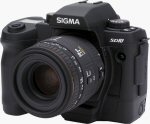 Sigma announces SD10 digital SLR (UPDATED)
Sigma announces SD10 digital SLR (UPDATED)
By
Mike Tomkins
(Sunday, October 26, 2003 - 19:00 EST)
Sigma Corp. has today announced its second digital SLR in the form of an update to the existing SD9 model, famed for its use of Foveon's much-discussed X3 image sensor.
When it was announced in February 2002, the Foveon X3 sensor was seen by many as the future of digital photography because (unlike almost every camera on the market which uses a color filter array), the X3 sensors measure color information for all three colors at every pixel location. Sigma's SD9, announced alongside Foveon's X3, was the launch camera for the technology - and to date has remained the only product on the market with full-measured color. A year after the SD9 first shipped, Sigma and Foveon's partnership continues with the announcement of a new sensor and camera alongside each other once more. The new Sigma SD10 looks almost identical to its predecessor externally, although there are a few tweaks to the design which we'll get to in a minute. The real meat of the changes are to the camera's internals and the bundled software, however. Most noteably, the SD10 uses an all-new image sensor which, although it has the exact same resolution as that used in the SD9, features a new design with microlenses. You'll find a commentary on the newly-announced sensor in a separate news item - the overall changes between the SD9 and SD10 are summarised as follows: Hardware - New Foveon F7X3-C9110 X3 Pro 10M image sensor with microlenses. Sigma says that the new sensor offers increased dynamic range, reduced noise and improved color accuracy.
- New AE sensor and circuitry
- Uses only one set of batteries - secondary CR-123A (DL-123A) batteries in hand-grip no longer required
- Contouring of hand-grip is different and grip is slightly smaller (due to removal of secondary batteries)
- Battery tray has much larger contacts and heavier-duty springs, as well as small "levers" to help remove the batteries. Sigma tells us this is the same as the updated tray that was released for the SD9 to cure problems with NiMH batteries, and it is certainly a much better design than the original tray we received when we tested that camera.
- "Cancel" and "OK" buttons on the rear of the camera, originally black with a white screen-printed logo similar to the camera's other buttons, are now colored rubber (red for "Cancel", blue for "OK") - making it less likely you'll press the wrong button.
Firmware
(some changes related to the hardware changes above) - Maximum ISO rating increased. On the SD9 choices were ISO 100 - 400; on the SD10 this is ISO 100 - 800, with the ability to extend to ISO 1600.
- Long exposures can be much longer. On the SD9, the maximum was 15 seconds at ISO 100, and 1 second at ISO 200 or 400. On the SD10, the default is 15 seconds at ISO 100 / 200, and 4 seconds at ISO 400 / 800. Additionally, in extended mode you can shoot exposures as long as 30 seconds in all ISO ratings.
- Bulb mode differences. On the SD9, bulb was available only at ISO 100. The SD10 bulb setting is available at ISO 100 and 200 by default; if you put the camera in extended mode, it is available in every ISO rating. Curiously it is still limited to approximately 15 seconds in all modes in which it is available (even though the camera itself is capable of shots as long as 30 seconds as mentioned above).
- Long exposures of 5 seconds or greater now have mirror lockup enabled even when you're not using the "UP" mode of the camera.
- Exposure compensation increments are finer. Where the SD9 was + / - 3.0EV in 1/2EV steps, the SD10 is + / - 3.0EV in 1/3EV steps. This also applies to flash exposure compensation with either the Sigma EF500 DG ST SA-N or Sigma EF500 DG Super SA-N flash units.
- Wireless TTL flash compatibility. Alongside the SD10, Sigma is announcing a new EF500 DG Super SA-N Electronic Flash unit which has an off-camera wireless dedicated flash mode. According to Sigma's documentation, the SD9 cannot do Wireless TTL.
- New AF algorithm. Sigma says that the autofocusing algorithm has been improved and should offer "enhanced AF performance" overall. The most significant improvements are apparently in AF performance under low-light situations.
- According to the Sigma Photo Pro 2.0 release notes, "The imager operating parameters have been optimized to avoid a tendency to highlight blowouts and 'blooming' in some overexposed and long-exposure shots. This change improves night shots, shots with the sun in the image, and such."
Software
(Version 2.0 of Sigma Photo Pro comes with the SD10, including numerous changes as follows) - New "X3 Fill Light" slider, using Foveon-developed technology, aims to simulate the effect of "dodge and burn" in film photography, or perhaps a bounce reflector or fill flash on location when a photo was taken. See the separate news item on Foveon's announcement of X3 Fill Light for further details.
- All changes made in Sigma Photo Pro's "Adjustment Controls" panel can be saved into the original X3F file. If you later decide you want to regress the changes, you can reset the file to its original out-of-camera condition. This also applies to images captured with the original Sigma SD9.
- Adjustment settings applied to X3F files before saving them as TIFF and JPEG files are stored in those files as fields in the Exif MakerNote along with other details from the camera and the processing software.
- White balance settings can now be changed as a batch from within the Sigma Photo Pro "Browser".
- The CMY "Color Adjustment" circle on the Adjustment Controls panel now has index marks on it to show 5 unit steps of each color.
- Instead of "Default", the adjustment settings stored in the X3F file is now referred to as the "X3F" setting, making it clearer that the setting is that of the individual X3F file, not a program-wide default.
- The information window now shows extra information including an "Image Unique ID" which identifies the source X3F file, allowing you to confirm which files came from the same source image, The information window also contains the custom processing settings that have been saved to an X3F file, or were applied to the file before saving it as a TIFF or JPEG
- Network support. In the v1.x versions of Sigma Photo Pro there was no way to open an X3F file that wasn't on your own machine. v2.0 now lists an extra "drive" titled "Network" in the browser tree - from where you can access drives on other computers in your network.
- Increased processing speed. Sigma told us that Photo Pro is faster than before, although no specific figures were given. Specific speed improvements are apparently to be found in thumbnail loading and display time for X3F, TIFF and JPEG, as well as improvements in responsiveness of the user interface when the computer is heavily loaded.
- Other unspecified bug fixes, etc.
Other
(A quick summary of the changes of lesser importance that we noticed) - SD10 logos instead of SD9 logos on the front and bottom of camera (of course!)
- Slightly different labelling of the IEEE1394 FireWire port (a clear arrow, instead of the possibly confusing line to indicate which port the text refers to).
So - under the skin, the Sigma SD10 has quite a few changes! We don't currently have information on planned pricing (edit: see the update below, we now have rumored information on Japanese pricing from a credible source), but the camera should be available for purchase from November 14th, 2003. Owners of the Sigma SD9 will be very pleased to hear that Sigma Photo Pro v2.0 will be offered to them as a free upgrade - the changes are quite significant, particularly the new "X3 Fill Light" slider, the ability to save settings in the original X3F file, and the ability to batch-change white balance settings. We currently have a near-production level Sigma SD10 in hand, and will shortly be posting a full review including our usual batch of comparison photos taken with it. We will also have a gallery of real-world samples (we apologise ahead of time if the scenes aren't the world's most interesting, but News Editor Mike Tomkins - who drove from Tennessee to help with the review, and took the gallery photos - isn't familiar with the Atlanta area and hence had to find suitable locations "on the fly"). Check back shortly for our verdict on the changes in the SD10, and how the camera performs as a whole. You can also find the official Sigma SD10 product brochure for download from our server (with permission of Sigma) by clicking here - note that the brochure is saved as an Adobe Acrobat PDF file, for which you will need a recent version of the free Acrobat Reader. Finally, for full specifications and the official press release, courtesy of Sigma, read on: | Sigma SD10 | 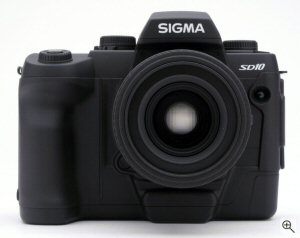 | | Storage Media | CompactFlash™ (CF) (TypeI/II), Microdrive™ | | Image Sensor Size | 20.7mm ×13.8mm | | Lens Mount | SA Bayonet Mount | | Actual Field of View | Equivalent to 1.7x the focal length of lens when used on a 35mm SLR | | Usable Lenses | Sigma SA mount lenses | | Image Sensor | FOVEON® X3™ (CMOS) | | Number of Pixels | 10.29Million (2268 x 1512 x 3 Layers) | | Aspect Ratio | 3 : 2 | | Image Recording Format | Lossless compression RAW Data (12-bit) | | Resolution (File Size) | | (1) HI:2268×1512x3 layers (Approx. 8MB) | | (2) MED:1512x1008x3 layers (Approx. 4MB) | | (3) LOW:1134x756x3 layers (Approx. 2MB) | | | Continuous shooting Speed | HI:1.9 fps , MED:2.4 fps, LOW:2.5 fps | | Maximum number of frames for continuous shooting | | HI: 6 frames | | MED: 14 frames | | LOW: 30frames | | | Interfaces | IEEE1394 (Firewire), USB (1.1), Video Out (NTSC/PAL) | | White Balance | 8 types (Auto, Sunlight, Shade, Overcast, Incandescent, Fluorescent, Flash and Custom) | | Viewfinder Type | Pentaprism SLR Viewfinder | | Viewfinder Frame coverage | 97% vertical , 98% horizontal | | Viewfinder Magnification | 0.77x (50mm F1.4_8) | | Eyepoint | 18mm | | Diopter Adjustment Range | -3dpt ~ +1dpt | | Auto Focus Type | TTL phase difference detection system | | AF Operating Range | EV2 to 18 (ISO100) | | Focus Mode | AF-S (single), AF-C (continuous), with AF motion prediction function | | Metering Systems | 8-segment Evaluative Metering, Center Metering, and Center-Weighted Average Metering | | Metering Range | EV1 to 20 (with 50mm F1.4 at ISO100) | | Exposure Modes | (P) Program AE (with program shift function), (S) Shutter Speed Priority AE,(A) Aperture Priority AE, (M) Manual | | ISO Sensitivity | Equivalent to ISO 100, 200, 400, 800. Extended Mode: 1600 | | Exposure Compensation | ±3EV (in 1/3steps) | | AE Lock | Pushbutton type (exposure settings are locked while the button in depressed) | | Auto Bracketing | Three Different Exposure Levels; Appropriate, Under and Over Exposure; Maximum variation of ±3EV in 1/3 EV steps | | Shutter Type | Vertical-travel metal focal plane shutter electronically controlled through entire speed range | | Shutter Speeds | | 1/6000sec. to 15sec.(ISO100,200), 1/6000sec. to 4sec(ISO400,800), Bulb (ISO100,200 up to 15 sec.) | | Extended Mode: 1/6000 to 30sec., bulb up to 30 sec. (ISO 100 to 1600) | | | External Flash Synchronization | Hot shoe (contact X, synchronized at 1/180-sec. or less, with dedicated flash linking contact) | | LCD Monitor Type | | 1.8", Color TFT LCD with about 130,000 dot low-temp. polysilicon | | Coverage Area : 100% Backlight : White LED | | | Reviewing Images | Single-Image Display, Zoom-in Display, 9 images thumbnail display, Slide Show | | Menu Languages | Japanese / English / French / German | | Power Source | 3V lithium battery (CR-V3) x 2pcs., or Ni-MH x 4pcs, Nickel Zinc Primary Battery x 4pcs. Dedicated AC Adapter | | Dimension and Weight | | Dimensions : 152(W)mm x 120(H)mm × 79(D)mm / 5.9in (W)X 4.7in (H)X3.1in(D) | | Weight : 785g / 27.7 oz | | | Bundled accessories | SIGMA Photo Pro disk, dedicated AC adapter SAC-1, AC cable, dedicated USB cable, dedicated IEEE1394 (FireWire) cable, dedicated video cable, LCD monitor cover, strap, eyepiece cup, body cap. | | Optional accessories | Electronic Flash EF500 DG SUPER SA-N, Electronic Flash EF500 DG ST SA-N, Battery Grip Power Pack SD, Remote Controller RS-21, Cable Release CR-11, PC Syncro-terminal adapter ST-11 | | More Photos |  | 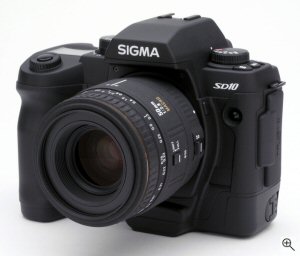 | 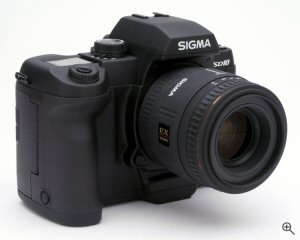 |  |  | 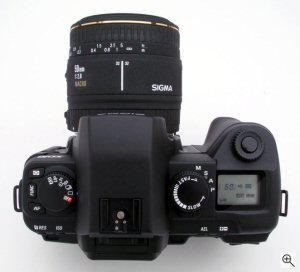 |  | | . |
UPDATED 2003-10-26 19:17ET: In a moment of brain fade, Mike forgot to mention something significant. We've heard a rumor from a reliable source that whilst Sigma Japan are quoting an "open price" - ie. no MSRP - for the camera in Japan, that it will have a street price of approximately ¥200,000. This equates to US$1836 / €1559 / CAD$2399 / £1083, ignoring exchange rate fluctuations, taxes and duties. One point we're trying to clarify (read the update below - we've got the answer now) is whether this is a price for the camera body only, or a kit price with lens(es). The camera body will be available in Japan for purchase alone, or in two kits - the SD10 IMAGING KIT (which includes an 18-50mm F3.5-5.6 DC lens), or the SD10 DIGITAL TWIN ZOOM KIT (which includes both the 18-50mm F3.5-5.6 DC lens and a 55-200mm F4-5.6 DC lens).
Details on product bundling and pricing outside of Japan aren't currently available. As noted above in the news item, the camera should be available from November 14th, so we are sure that official pricing for markets other than Japan will become clear soon.
UPDATED 2003-10-26 20:36ET: We've now had a confirmation from our reliable source suggesting that the Japanese price of ¥200,000 mentioned above is a body-only price, and does not include any lens(es)...
UPDATED 2003-10-26 21:02ET As you can probably tell, things are pretty fluid here as we've been hard at work on our review of the SD10 for several days. We've just updated this news item again, this time adding several more hardware and software changes to the list above (some of which were described in the Sigma Photo Pro 2.0 release notes). Also, we understand that there is a new version of firmware on the way for SD9 owners, incorporating improvements related to a tendency of the current firmware to "highlight blowouts and 'blooming' in some overexposed and long-exposure shots" .
UPDATED 2003-10-27 00:15ET: Ack! There was some confusion over the level of the firmware in our eval unit, and whether it was truly a "production level" camera. While there apparently will still be changes in the AE system and battery life, all image quality parameters are in fact production-level, as those aspects of the hardware and firmware are final, and the unit we received was subjected to full production-level calibration and certification. Apologies for the confusion, look for our full review, with a full set of sample images soon!
|
Original Source Press Release:
| 10.2 Million Pixels(2,268*1,512*3 layers) Digital Single Lens Reflex Camera. SD10 IMAGING KIT(18-50mm F3.5-5.6 DC)
SD10 DIGITAL TWIN ZOOM KIT (18-50mm F3.5-5.6 DC+55-200mm F4-5.6 DC) Sigma Corporation is pleased to announce the launch of the new Sigma SD10 Digital SLR camera. This high-definition digital SLR camera is powered by Foveon® X3™ image sensor, which captures all RGB colors at each and every pixel. 1. FOVEON X3® Direct Image Sensor
Foveon® X3™ direct image sensor in the Sigma SD10 digital SLR can capture all RGB colors at each and every pixel. The revolutionary design of Foveon® X3™ direct image sensor features three layers of pixel sensors Using three silicon-embedded layers of pixel sensors, stacked to take advantage of silicon’s ability to absorb red, green, and blue light at different respective depths, the Foveon X3® direct image sensor can thereby directly capture full color and detail at each and every pixel location, without interpolation. Other conventional image sensors feature just single layer of pixel sensors in a tiled mosaic pattern. Each pixel detects only one color of light, which has been filtered through a single red or green or blue color filter. As a result, two thirds of the color information at each pixel is blocked out. To compensate, the missing color is estimated through a complicated process of color interpolation, leading to color errors, color artifacts and loss of image detail. Sigma SD10, powered by Foveon X3® direct image sensor, however, captures all three colors at every pixel location, ensuring the capture of full, complete color. It efficiently reproduces color more accurately, and offers sharper resolution, pixel for pixel, than any conventional image sensor. 2. RAW Image Format
With the RAW data recording system of the SIGMA SD10, it is possible to obtain high picture definition and compact file size. The lossless compression system of RAW data, eliminates image deterioration, provides superior pictures, without sacrificing original image quality and retains full image capture details. 3. Three Resolution Settings
Depending on the intention of the photographer, the SIGMA SD10 allows photographers to select the resolution of RAW data images in one of three resolutions. HI mode (2268x1512x3 layers) delivers highest resolution image performance. MED mode (1512x1008x3 layers) has high definition and recording capacity. LOW mode (1134x756x3 layers) for capturing the most images per given memory capacity. 4. Exclusive SIGMA Photo Pro 2.0 Software
The SD10 comes with SIGMA Photo Pro 2.0 software for modifying recorded RAW data image files. It is easy to make adjustments (white balance, exposure, color balance, and contrast for example) in three modes. The X3F mode stores the original settings of the image at point of capture. In the auto adjustment mode the software analyzes and automatically makes adjustments of RAW data. The custom-mode allows the photographer to make individual adjustments to exposure, contrast, shadow, highlight, sharpness, and saturation. The latest addition to Sigma Photo Pro 2.0 software is X3 Fill Light. This easy to use facility corrects tones on images of high contrast exposure or back lit pictures. The under exposed areas of the image can receive extra exposure without “burning out” the highlight regions. Conversely, more detail can be obtained from over-exposed sections without plunging the more shaded areas into darkness. SIGMA Photo Pro supports 8-bit TIFF, 16-bit TIFF, and JPEG file formats and also outputs images in four-color space (s.a. sRGB and AppleRGB). The default setting for resolution is the same as the resolution selected when capturing the image on the camera (High, Medium, or Low). It is also possible to select one half, or double the resolution for the processed image. 5. ISO100 – 1600 setting
In Default or normal mode the ISO sensitivity of SD10 can be set to 100, 200, 400 and 800. If Extended Mode is selected, it is possible to use ISO 1600 sensitivity. In any ISO sensitivity setting, it is possible to select a high shutter speed from 1/6000 sec. to a slow shutter speed of 30secs.
*It is possible to see slight ”noise”, if the higher ISO sensitivity and shutter speeds are selected 6. Image Sensor Dust Protector
Most digital SLR cameras are typically vulnerable to dust entering the body especially when the lens is dismounted for changing. Dust and dirt entering through the lens mount of a digital camera, can create serious defects in image quality. The dust protector of the SIGMA SD10 prevents dust from entering and adhering to the image sensor. Even if dust adheres to the dust protector it will not have an influence on image quality, because the dust protector is located away from the image sensor and is therefore out of focus. 7. The Sports Finder
The coverage of a viewfinder of a digital SLR camera with interchangeable lens is almost the same as the picture seen on its image sensor. However, the coverage of viewfinder can be maximum 100%, and no portions of the outside area projected on the image sensor can be seen. SIGMA SD10 is equipped with a "sport finder" which offers a view that extends outside of the frame. The area that is out of the image sensor coverage range is marked by transparent light gray, to distinguish it from the active picture taking area. It is also important to monitor the area surrounding the photographic subject. In this respect, the sports finder makes the photographer aware of imminent photo opportunities. 8. Intuitive Interface
Clearly marked operation panel buttons make it easy for photographers to identify and use desired functions. Each button of the Sigma SD10 is devised and arranged to provide a functional and easy-to-use setting. The SD-10 is probably the most user – friendly digital SLR. It is always ready to shoot, even when reviewing earlier images. 9. Mirror lock-up Mechanism Prevents Camera Shake
The mirror lock-up mechanism raises the mirror thus preventing vibration when the shutter is released. This prevents camera shake, and is especially effective for macro photography, shooting scenes using telephoto lenses or scientific work. Use of a remote controller or cable release (sold separately) also reduces the possibility of camera shake. 10. Exposure Compensation and Auto Bracketing
It is possible to adjust exposure in 1/3 EV steps increments up to ±3 EV from the auto- exposure level set for the scene. In situations where it is difficult to determine proper exposure, the auto bracketing function allows a sequence of pictures to be taken of the same subject at three different exposure levels; Appropriate Exposure, Under Exposure and Over Exposure. 10. Non-stop shooting up to 30 frames
A high-speed CPU and high-volume buffer memory enable the SD10 to shoot at 2.5 frames per second for up to 30 consecutive frames in LOW mode, up to 14 consecutive frames in MED mode, and up to 6 frames in high-quality HI mode. 11. IEEE 1394 (FireWire) and USB Interfaces
The SIGMA SD10 can transmit the images from camera to computer with high-speed IEEE1394 (Firewire) and widely available USB interfaces. IEEE1394 (Firewire) interface delivers super-high-speed image data transmission rate. 12. Power Source
SD10 can be powered by two CR-V3 lithium batteries or four “AA” Ni-Mh batteries or four Nickel Zinc primary batteries or a dedicated AC adapter (included with the camera). Optional battery pack can hold four CR-V3 batteries or eight AA batteries more than enough power for most shoots. When using the camera indoors for an extended period of time or transferring the imaged to the computer, it is advisable to power the camera from a socket using the AC Adapter (provided). 13. Recording on CF cards and Microdrives
The Sigma SD10 records on reliable, high capacity Type I and Type II CF (CompactFlash) cards or a Microdrive to hold larger volumes of data. 14. 1.8”type TFT Monitor
The SIGMA SD10 is equipped with a large 1.8” appr.130,000 dot low temperature polysilicon TFT-LCD monitor with white LED on the back panel, which displays images, menus and histogram. The coverage area of the LCD monitor is 100%, of that seen from the viewfinder and thanks to the LCD-monitor, the composition can also be seen easily. By operation of +/- Controller, three types of screen display can be chosen; thumbnail display (9 images simultaneous display), Single-Image display, and a Zoom-in display (the area of magnification can be freely chosen by the 4-Way Controller). By pressing the INFO button, detailed image information can be displayed on the TFT-LCD monitor, such as shutter speed, aperture value etc. 15. NTSC/PAL
SIGMA SD10 camera’s video output system can be switched between PAL system (used in Europe, etc.,) and NTSC system (in Japan and the U.S., etc.). This means that video output of SIGMA SD10 pictures is possible in many parts of the world. 16. Wireless Flash Photography With Exclusive EF-500 DG SUPER
It is possible to enjoy the S-TTL Wireless Flash, if two optional electronic EF-500 DG SUPER flashguns are used. In the “Wireless Flash” mode, the camera will control the flash power level automatically. |
Powered by Coranto
|